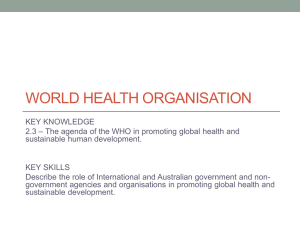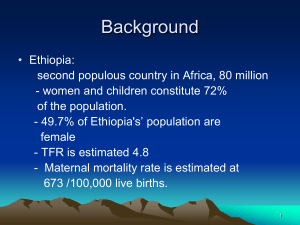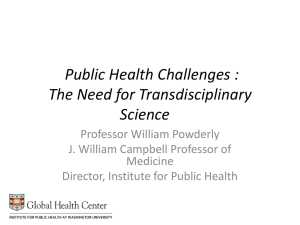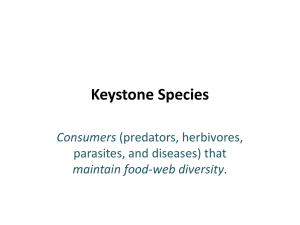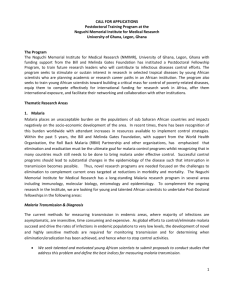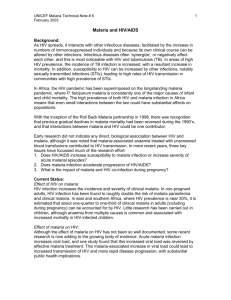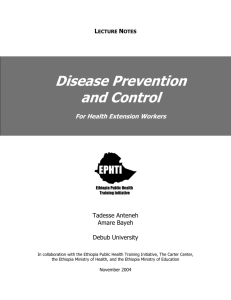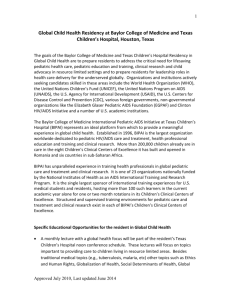why now is a critical moment in Global Fund advocacy
advertisement
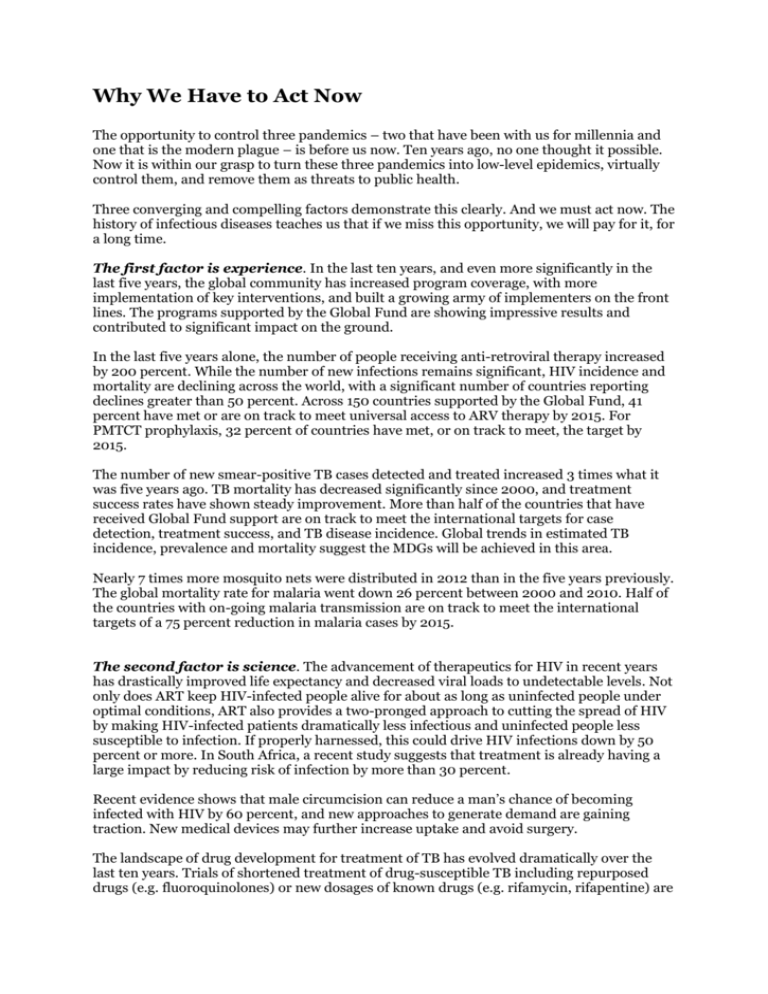
Why We Have to Act Now The opportunity to control three pandemics – two that have been with us for millennia and one that is the modern plague – is before us now. Ten years ago, no one thought it possible. Now it is within our grasp to turn these three pandemics into low-level epidemics, virtually control them, and remove them as threats to public health. Three converging and compelling factors demonstrate this clearly. And we must act now. The history of infectious diseases teaches us that if we miss this opportunity, we will pay for it, for a long time. The first factor is experience. In the last ten years, and even more significantly in the last five years, the global community has increased program coverage, with more implementation of key interventions, and built a growing army of implementers on the front lines. The programs supported by the Global Fund are showing impressive results and contributed to significant impact on the ground. In the last five years alone, the number of people receiving anti-retroviral therapy increased by 200 percent. While the number of new infections remains significant, HIV incidence and mortality are declining across the world, with a significant number of countries reporting declines greater than 50 percent. Across 150 countries supported by the Global Fund, 41 percent have met or are on track to meet universal access to ARV therapy by 2015. For PMTCT prophylaxis, 32 percent of countries have met, or on track to meet, the target by 2015. The number of new smear-positive TB cases detected and treated increased 3 times what it was five years ago. TB mortality has decreased significantly since 2000, and treatment success rates have shown steady improvement. More than half of the countries that have received Global Fund support are on track to meet the international targets for case detection, treatment success, and TB disease incidence. Global trends in estimated TB incidence, prevalence and mortality suggest the MDGs will be achieved in this area. Nearly 7 times more mosquito nets were distributed in 2012 than in the five years previously. The global mortality rate for malaria went down 26 percent between 2000 and 2010. Half of the countries with on-going malaria transmission are on track to meet the international targets of a 75 percent reduction in malaria cases by 2015. The second factor is science. The advancement of therapeutics for HIV in recent years has drastically improved life expectancy and decreased viral loads to undetectable levels. Not only does ART keep HIV-infected people alive for about as long as uninfected people under optimal conditions, ART also provides a two-pronged approach to cutting the spread of HIV by making HIV-infected patients dramatically less infectious and uninfected people less susceptible to infection. If properly harnessed, this could drive HIV infections down by 50 percent or more. In South Africa, a recent study suggests that treatment is already having a large impact by reducing risk of infection by more than 30 percent. Recent evidence shows that male circumcision can reduce a man’s chance of becoming infected with HIV by 60 percent, and new approaches to generate demand are gaining traction. New medical devices may further increase uptake and avoid surgery. The landscape of drug development for treatment of TB has evolved dramatically over the last ten years. Trials of shortened treatment of drug-susceptible TB including repurposed drugs (e.g. fluoroquinolones) or new dosages of known drugs (e.g. rifamycin, rifapentine) are presently on-going, with earliest results expected in 2013/14. For the first time in nearly 50 years, two new molecular entities proposed for the treatment of MDR-TB are making their way through the regulatory pathway in the EU and the US. Additionally, other new compounds and novel combinations of drugs are being investigated for the treatment of DS and/or MDR/XDR-TB. Treatment shortening regimens and substitution compounds for existing regimens are also being investigated. The arrival of more effective and faster TB diagnostic tools and their increasingly widespread use are expected to allow targeted treatment which should provide the greatest opportunity for stopping the tuberculosis epidemic in the coming years. GeneXpert allows for diagnosis of MDR-TB in a matter of hours, reduced from 7-8 weeks. Equally promising advances in anti-malaria treatment, in particular to counter drug resistance and the development of cheaper and faster diagnostic tests have also emerged in recent years. New conceptual and technological advances indicate that it may be possible to develop vaccines against HIV, TB and malaria within the next 10 years. If incidence decreases to levels around 0.5 percent, and continue on a downward trajectory, a cure with only 50 percent efficacy can further drive down the epidemics. History with infectious diseases has taught us that you need 70-100 percent efficacy for cures if there is an upward trajectory in incidence. Pulling back even a little now could result in resurgence, rather quickly in the case of malaria. The third factor is better epidemiology. A better understanding of the drivers of the epidemics and the experience we have gained in implementing interventions to fight them now allow partners to focus efforts on areas where the greatest impact can be achieved. Targeting interventions at identified areas, geographically and persons at greatest risk of infection, is improving effectiveness. For instance, HIV spreads through intimate relationships that tend to be formed locally and its spread can be eased by practises and traditions that are specific to communities. So, in many settings HIV exists in clumps – or hotspots – amid a sea of much lower levels of infection. According to one mode, impact could increase by 20 percent, just by redirecting the same resources to the populations at greatest risk of HIV infection and transmission. The spread of disease can be better controlled through a combination of treatment and prevention methods, and the numbers prove it. We’ve made great strides in the fight against malaria through significantly increased global investment in a combination of effective treatment and prevention measures. Today, the malaria map is shrinking. Malaria deaths in Africa are down by one-third, and worldwide by one-quarter, compared with in 2000. The last World Malaria Report in 2012 shows that of the 104 malaria-endemic countries, 50 are on track to reduce malaria incidence rates by 75 percent by 2015. Nine of these are in Africa. More than a million lives have been saved from malaria since year 2000, mainly among children under 5 years of age. The opportunity is now. Now that we have the tools and have gathered sufficient lessons from the ground, we can leverage the new intelligence we have on the epidemics to squeeze even more impact out of the resources we have. It is important to capitalize on the investments the international community has collectively made in the past ten years in allocating domestic resources and other external funding in health and disease programs and on the gains in terms of results and impact we have achieved so far. The HIV, TB and malaria epidemics can bounce back if the pressure we have applied to them is released, even for a moment. The economics of interventions against these infectious diseases mean that, as we are beginning to see downturns in infection levels, now is the time to invest: the interventions we need would not be possible if we returned to phase of rapid epidemic growth. The impact that we now think we can achieve would make the epidemic much more fragile – so that an additional intervention could be the fatal blow. Scientific investigation into possible new forms of treatment and vaccines are continuing at a rapid pace, and no one would bet against further breakthroughs. Investment now – in the right interventions for the right populations at the right time – would save millions of lives. It will also “soften” the epidemics and give the goal of the world free of HIV, TB and malaria scientific backing. By investing now, we will be known as the generation that seized the historic opportunity presented by developments in science and technology, our improved knowledge of the diseases and learning from implementation of programs around the world. We have changed the trajectory of the three diseases, and we have the opportunity to defeat them. That’s why we have to act now.

